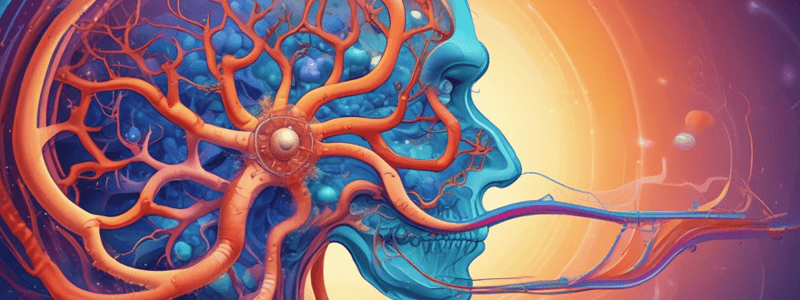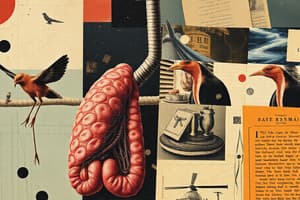Podcast
Questions and Answers
What is the role of alveolar macrophages in the respiratory system?
What is the role of alveolar macrophages in the respiratory system?
- Producing antimicrobial peptides
- Producing mucus for airway defense
- Defending against inhaled particles (correct)
- Enhancing venous return
Which of the following is NOT a function of the respiratory system?
Which of the following is NOT a function of the respiratory system?
- Helping maintain acid-base balance
- Controlling the vocal cords
- Enhancing venous return
- Producing antimicrobial peptides (correct)
How does cystic fibrosis affect the mucociliary escalator?
How does cystic fibrosis affect the mucociliary escalator?
- It enhances ciliary beating
- It blocks chloride pumps leading to mucus build-up (correct)
- It increases fluid production
- It promotes movement of mucus
Which component of the respiratory tract produces mucus for airway defense?
Which component of the respiratory tract produces mucus for airway defense?
What happens to the mucociliary escalator in cystic fibrosis patients?
What happens to the mucociliary escalator in cystic fibrosis patients?
Which functional feature of alveoli contributes to gas exchange between air and blood?
Which functional feature of alveoli contributes to gas exchange between air and blood?
What is the impact of cigarette smoke on airway defenses?
What is the impact of cigarette smoke on airway defenses?
How does additional mucus production affect individuals with cystic fibrosis?
How does additional mucus production affect individuals with cystic fibrosis?
What is the main role of alveolar macrophages in the respiratory system?
What is the main role of alveolar macrophages in the respiratory system?
Which component of the respiratory system is responsible for moving air in and out of the airways and lungs?
Which component of the respiratory system is responsible for moving air in and out of the airways and lungs?
What are the functional features of alveoli that aid in gas exchange?
What are the functional features of alveoli that aid in gas exchange?
In cystic fibrosis, which aspect of the respiratory system is primarily affected?
In cystic fibrosis, which aspect of the respiratory system is primarily affected?
What is the main function of the airway in the respiratory system?
What is the main function of the airway in the respiratory system?
Which respiratory system component is described as involving two types of alveolar cells, Type I and Type II?
Which respiratory system component is described as involving two types of alveolar cells, Type I and Type II?
What is the role of pneumocytes in the alveoli?
What is the role of pneumocytes in the alveoli?
What aspect related to breathing does Boyle's Law explain?
What aspect related to breathing does Boyle's Law explain?
What happens when the external intercostal muscles contract?
What happens when the external intercostal muscles contract?
During forced expiration, which muscles are involved?
During forced expiration, which muscles are involved?
How is oxygen carried in the blood?
How is oxygen carried in the blood?
What is used to measure the haemoglobin in the blood?
What is used to measure the haemoglobin in the blood?
Which of the following factors affects oxygen carriage by hemoglobin?
Which of the following factors affects oxygen carriage by hemoglobin?
What happens to the oxygen-haemoglobin dissociation curve when pH decreases?
What happens to the oxygen-haemoglobin dissociation curve when pH decreases?
How does an increase in temperature affect the oxygen-haemoglobin dissociation curve?
How does an increase in temperature affect the oxygen-haemoglobin dissociation curve?
Which muscles are primarily involved in forced expiration?
Which muscles are primarily involved in forced expiration?
What happens to lung pressure during inhalation?
What happens to lung pressure during inhalation?
Explain the behavior of hemoglobin when oxygen pressure decreases.
Explain the behavior of hemoglobin when oxygen pressure decreases.
How does a decrease in pH affect the oxygen-hemoglobin dissociation curve?
How does a decrease in pH affect the oxygen-hemoglobin dissociation curve?
What effect does an increase in temperature have on the oxygen-hemoglobin dissociation curve?
What effect does an increase in temperature have on the oxygen-hemoglobin dissociation curve?
How does carbon dioxide affect oxygen carriage by hemoglobin?
How does carbon dioxide affect oxygen carriage by hemoglobin?
What is the term for the measurement of the amount of hemoglobin in the blood?
What is the term for the measurement of the amount of hemoglobin in the blood?
What is the main function of the oxyhemoglobin dissociation curve?
What is the main function of the oxyhemoglobin dissociation curve?
Describe the sensitivity of hemoglobin to oxygen pressure.
Describe the sensitivity of hemoglobin to oxygen pressure.
How do different factors like pH, temperature, and carbon dioxide affect oxygen carriage by hemoglobin?
How do different factors like pH, temperature, and carbon dioxide affect oxygen carriage by hemoglobin?
During forced expiration, the internal intercostal muscles are primarily responsible for the contraction.
During forced expiration, the internal intercostal muscles are primarily responsible for the contraction.
The oxyhemoglobin dissociation curve is linear, meaning it releases oxygen at a constant rate.
The oxyhemoglobin dissociation curve is linear, meaning it releases oxygen at a constant rate.
Haemoglobin has a high affinity for oxygen, holding onto it tightly even when there is a low availability of oxygen.
Haemoglobin has a high affinity for oxygen, holding onto it tightly even when there is a low availability of oxygen.
During expiration, the diaphragm relaxes and moves up, while the ribcage moves down and outwards.
During expiration, the diaphragm relaxes and moves up, while the ribcage moves down and outwards.
Inhalation leads to a decrease in lung pressure, allowing air to flow into the lungs.
Inhalation leads to a decrease in lung pressure, allowing air to flow into the lungs.
What determines the Co2, PO2 and H+ conc?
What determines the Co2, PO2 and H+ conc?
what are 2 types of chemoreceptors?
what are 2 types of chemoreceptors?
where is central chemoreceptors found?
where is central chemoreceptors found?
where are peripheral chemoreceptors found?
where are peripheral chemoreceptors found?
phrenic nerve innervates the intercostal muscles
phrenic nerve innervates the intercostal muscles
what nerves are stimulated in peripheral chemoreceptors?
what nerves are stimulated in peripheral chemoreceptors?
where is respiratory centre found?
where is respiratory centre found?
Flashcards are hidden until you start studying
Study Notes
Cellular and External Respiration
- Cellular Respiration: Utilizes oxygen (O2) and produces carbon dioxide (CO2) and energy.
- External Respiration: Involves gas exchange; four steps include ventilation, exchange of gases in alveoli, transport of gases via blood, and cellular exchange.
Steps of External Respiration
- Ventilation: Gas exchange between the atmosphere and alveoli.
- Alveolar Exchange: O2 and CO2 exchanged between alveolar air and blood.
- Transport: Blood carries O2 and CO2 between lungs and tissues.
- Tissue Exchange: O2 and CO2 exchanged between blood in capillaries and tissue cells.
Non-Respiratory Functions
- Defense Mechanism: Alveolar macrophages protect against inhaled particles.
- Homeostasis: Maintains acid-base balance and eliminates heat and water.
- Vocal Cord Control: Regulates sound production.
- Venous Return Enhancement: Aids in blood circulation.
Airway Defenses
- Goblet Cells: Produce mucus to trap particles.
- Bronchi Epithelial Cells: Generate antimicrobial peptides.
- Ciliated Cells: Move mucus towards the throat using ciliary action.
- Mucus Composition: Comprised of glycoproteins and is wafted by cilia in a periciliary fluid layer.
Cystic Fibrosis Impact
- Lack of Chloride Pumps: Disrupts fluid movement, leading to mucus accumulation.
- Bacterial Growth: Warm, stagnant mucus promotes infections and breathing difficulties.
- Cilia Paralysis: Cigarette smoke damages cilia, exacerbating mucus blockage.
Respiratory System Components
- Airways: Conduct air; no gas exchange occurs here (e.g., trachea).
- Lungs: Primary sites for gas exchange (e.g., alveoli).
- Muscles: Facilitate airflow in and out of lungs.
Alveoli Features
- Capillary Network: Rich blood supply enhances gas exchange.
- Thin Walls: Facilitate effective diffusion of gases.
- Macrophages: Provide immune defense within alveoli.
- Pneumocytes:
- Type I: Thin, flat cells for gas exchange.
- Type II: Secrete pulmonary surfactant to reduce surface tension.
Mechanics of Breathing
- Pressure Changes: Positive pressure is needed to push air into lungs; negative pressure allows air to flow in.
- Boyle’s Law: Pressure and volume are inversely related; increased lung volume decreases pressure for airflow.
- Structural Requirements:
- Elastic tissues for volume changes.
- Support structures to prevent collapse.
- Musculature for volume modification.
Breathing Structures
- Diaphragm: Main muscle for inspiration.
- Intercostal Muscles: Aid in ribcage movement for breathing.
- Accessory Muscles: Assist in deep breathing and increased airflow when needed.
Inspiration Process
- Active Phase: Diaphragm contracts, resulting in ribcage expansion, increasing lung volume and drawing air in.
Studying That Suits You
Use AI to generate personalized quizzes and flashcards to suit your learning preferences.




